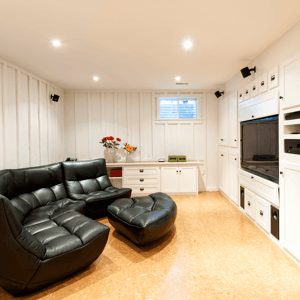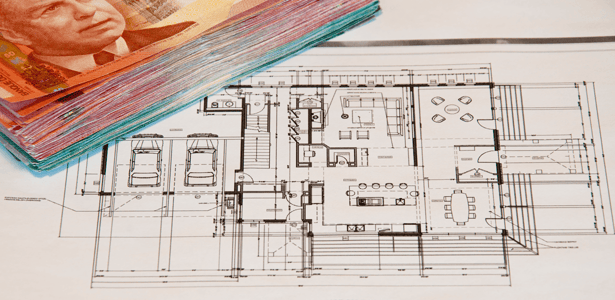A finished basement is like a well-kept secret, and can serve many purposes throughout its life; rec room, storage facility, man cave, 20-something's first apartment, etc. A finished basement also adds value to your home.
If you are one of the many homeowners looking to make the change from unfinished to fully functional, it's important to know in advance what the costs are and how much you'll need to budget to get the job done.
Below are nine ways you can financially prepare for finishing a basement. Keeping these tips in mind throughout the process will not only help you budget but also alleviate some stresses along the way.
Measure
Once you’ve decided to finish the basement, the first thing you need to do is measure. With a standard tape measure, measure the existing walls. Experts believe that measuring is one of the biggest factors in helping you determine what your basement will cost. In the event you’re planning to add additional walls, lay a line of tape on the floor equivalent to the length of the future wall and measure it. This will be approximate of course, but it will help you factor in the costs of added walls.
Get a Blueprint
Even if you want to take the DIY route, a professional basement design is necessary to know exactly what you're getting yourself into. Not only will a blueprint give you a better idea of what supplies you'll need and in what quantities, it will also give you insight into the amount of time it will take to complete and what labour will be involved.
Work in Phases
A lot of work goes into completing a basement. Don't do a mishmash of jobs and expect it to turn out great. Break the completion of the job down into phases. First, start with the walls. A completely unfinished basement will need framing and insulation installed before any actual walls go up. This is why having a blueprint is so important. Knowing how many rooms your basement will have and the exact layout makes the process of developing these phases much easier.
Know Your Costs
Regardless of whether you are planning to take the DIY route or hiring a professional contractor, know what your biggest expenses are going to be ahead of time. For example, on a $16,000 budget, the framing accounts for only 7.0% (approximately) whereas the drywall will account for around 18.6%.
Since the biggest cost culprits are generally drywall, trim and doors, and adding a bathroom, it would be beneficial to plan ahead of time. This will help you know exactly what kinds of costs you can expect for each stage of the renovation.
 Shop Around
Shop Around
For flooring, plumbing, appliances, decor - even contractors and trades. Price can vary drastically among different stores and companies, and you can potentially save yourself thousands of dollars by verifying different prices.
Be Your Own Contractor
You can save $10 - 13,000 on average by being your own general contractor. This doesn't mean you have to do any of the hard work, just that you oversee all of the scheduling, pricing, design, trades and purchasing.
Put Your Safety First
Don't expect to have your basement done and still be a safe place for less than $1300. A DIY project is always helpful in terms of cutting costs, but you need to know where to draw the line, especially for safety reasons. Make sure your project is backed by the proper permits and safety requirements- don’t cut corners to save money. If there are safety concerns, handing the project over to a professional may not only save you money in the long run- it could very well save your life.
Buy Your Own Tools
You can buy reconditioned tools for 30 to 50% less than the cost of new ones. They get the job done just as well but for half the price. You can use the money you save to pay for better flooring, furnishings or other construction costs.
Do Your Own Decorating Slowly
Start with the paint. If you have decided to go with a professional to build your basement, consider doing your own painting at the end. Painting is an easy job and rather inexpensive when done on your own.
Once your basement is finished, start adding decor slowly. Start with a few pieces to make the space functional and over time, you can add additional furniture and items. Taking your time will not only help you find pieces you love, it will keep you from breaking the bank on decor.
If you have made a commitment to finish your basement there are plenty of tips and hints to help you along the way. Ultimately, renovations can be costly, but you can save yourself thousands if you're conscientious.
Know your options and weigh the pros and cons of each before going all-in (remember DIY isn’t always better!) As stressful as it may be at times, overseeing the construction of your basement won't just leave you with an awesome new place to hangout, you will take satisfaction in knowing that its done right.




